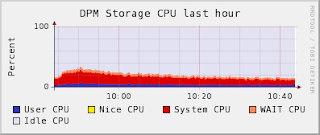I was going to post all the fun I had trying to install the cream CE but for brevity I have moved that to a ScotGrid wiki page and will just show it working with the WMS. In order to test it working on our mini cluster I installed a site bdii and changed LCG_GFAL_INFOSYS such that lcg-infosites on the UI picked up the mini cluster CE's.
-bash-3.00$ lcg-infosites --vo vo.scotgrid.ac.uk ce
#CPU Free Total Jobs Running Waiting ComputingElement
----------------------------------------------------------
.....
1912 5 4 0 4 dev011:8443/cream-pbs-q30m
1912 8 4 0 4 dev010:2119/jobmanager-lcgpbs-q30m
a whipped cream example:
-bash-3.00$ cat whippedcream.jdl
Type = "Job";
JobType = "Normal";
Executable = "double.sh";
StdOutput = "hw.out";
StdError = "hw.err";
InputSandbox = {"double.sh"};
OutputSandboxBaseDestURI = "gsiftp://dev008/clusterhome/home/gla057/cream/job_output";
OutputSandbox = {"hw.out", "hw.err"};
Requirements = other.GlueCEUniqueID == "dev011:8443/cream-pbs-q30m";
submission to cream ce through a WMS:
-bash-3.00$ glite-wms-job-submit -a --vo vo.scotgrid.ac.uk --debug -r dev011:8443/cream-pbs-q30m whippedcream.jdl
can we see the job in torque? Yes we can.
svr016:~# qstat | grep sco
2214311.svr016 cream_034614244 scotg001 0 W q30m
Has it worked through the cream ce? Yes!
-bash-3.00$ glite-wms-job-status https://dev009:9000/l4-RXjbtZbk1g00moK2IWA
*************************************************************
BOOKKEEPING INFORMATION:
Status info for the Job : https://dev009:9000/l4-RXjbtZbk1g00moK2IWA
Current Status: Done (Success)
Logged Reason(s):
- job completed
- Job Terminated Successfully
Exit code: 0
Status Reason: Job Terminated Successfully
Destination: dev011:8443/cream-pbs-q30m
Submitted: Fri Mar 6 16:28:15 2009 GMT
*************************************************************
It also appears there is no need to ask for the job output as this is automatically gsiftp'd to your output sandbox dir specified in the jdl.
-bash-3.00$ glite-wms-job-output https://dev009:9000/l4-RXjbtZbk1g00moK2IWA
Connecting to the service https://dev009:7443/glite_wms_wmproxy_server
Error - Output not Allowed
Output files already retrieved
One point to note is that you now have to run a gridftp server to stage successful output from the cream CE. This is also useful for staging files in especially if you want to bypass WMS inputSandbox size limitations imposed by sites. For a more in-depth account of the install you can check out the ScotGrid wiki. This may help if you encounter anything weird.





